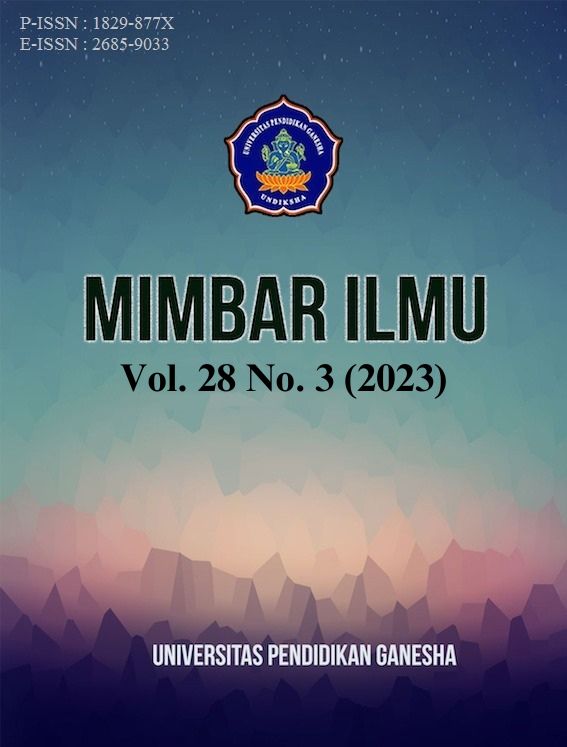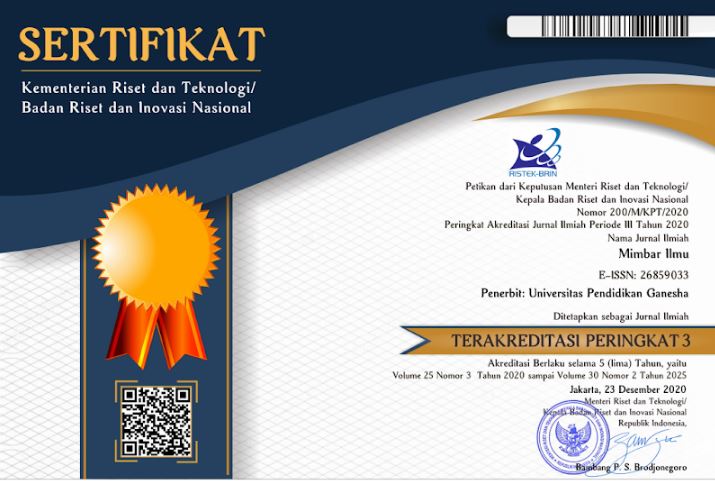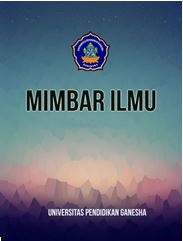Development of Equation for Predicting of Outdoor Thermal Comfort for Individuals During Nighttime in Tropical Humid Climate
DOI:
https://doi.org/10.23887/mi.v28i3.61014Kata Kunci:
Comfort, Outdoor, Heat, Night, TropicalAbstrak
The sun's heat factor is the leading cause of discomfort when doing outdoor activities, which does not happen at night. However, it is also necessary to ensure that humans feel comfortable at night, even without sunlight. This study aims to develop a regression equation to predict the comfort scale of humans doing outdoor activities at night in humid tropical climates. This study applied a field research method involving 80 adult respondents consisting of 40 men and 40 women in an outdoor location in a humid tropical climate. The data collection method uses a questionnaire. Respondents as subjects were asked about their comfort level when they received local climate penetration that touched their bodies. At the same time, climate variables around the issue were measured. The climate measured consists of air temperature, radiation temperature, relative humidity, and air speed. The data analysis technique is quantitative descriptive. The research results found 2 regression equations, namely for the case of people sitting and walking casually. The regression equation was then validated by comparing it with other equations, namely PMV and PET. The regression equation from this study helps make decisions about facilities and outdoor space design that provide a sense of comfort for humans during the funeral.
Referensi
Aghamolaei, R., Azizi, M. M., B, A., & O’Donnell, J. (2022). A comprehensive review of outdoor thermal comfort in urban areas: Effective parameters and approaches. A Review Paper. Energy & Environment, 1–24. https://doi.org/10.1177/0958305X221116176. DOI: https://doi.org/10.1177/0958305X221116176
Ballinas, M., Morales-Santiago, S. I., Barradas, V. L., Lira, A., & Oliva-Salinas, G. (2022). Is PET an Adequate Index to Determine Human Thermal Comfort in Mexico City? Sustainability, 12539. https://doi.org/10.3390/su141912539. DOI: https://doi.org/10.20944/preprints202206.0275.v1
Baruti, M. M., E, J., & Åstrand, J. (2023). Review of studies on outdoor thermal comfort in warm humid climates: challenges of informal urban fabric. International Journal of Biometeorology, 63, 1449–1462. https://doi.org/10.1007/s00484-019-01757-3. DOI: https://doi.org/10.1007/s00484-019-01757-3
Callejas, I. J., Durant, L. C., Diz-Mellado, E., & Galán-Marín, C. (2020). Thermal Sensation in Courtyards: Potentialities as a Passive Strategy in Tropical Climates. Sustainability, 12, 6135. https://doi.org/10.3390/su12156135. DOI: https://doi.org/10.3390/su12156135
Diani, R. (2015). Pengembangan Perangkat Pembelajaran Fisika Berbasis Pendidikan Karakter dengan Model Problem Based Instruction. Jurnal Ilmiah Pendidikan Fisika Al-Biruni, 4(2), 243–255. https://doi.org/10.24042/jpifalbiruni.v4i2.96. DOI: https://doi.org/10.24042/jpifalbiruni.v4i2.96
E., P. S., & Kusumawanto, A. (2019). Thermal comfort simulation on Cik di Tiro corridor. DIMENSI − Journal of Architecture and Built Environment, 46(1), 67–78. https://doi.org/10.9744/dimensi.46.1.67-78. DOI: https://doi.org/10.9744/dimensi.46.1.67-78
Fang, Z., X, F., & Lin, Z. (2017). Investigation of PMV Model for Evaluation of the Outdoor Thermal Comfort. Procedia Engineering, 205, 2457–2462. DOI: https://doi.org/10.1016/j.proeng.2017.09.973
Gupta, S., P, A., & Shashwat. (2015). Improvement of outdoor thermal comfort for a residential development in Singapore. International Journal of Energy and Environment, 6(6), 567–586. https://www.ijee.ieefoundation.org.
Hildegardis, C., A, A. O. S. A., D, G. A. D. I., & K, A. D. N. (2019). Student Perception of Thermal Comfort of Outdoor Space in Nusa Nipa University, Maumere, East Nusa Tenggara. International Journal of Engineering and Emerging Technology, 4(2), 15–19. https://doi.org/10.24843/IJEET.2019.v04.i02.p04. DOI: https://doi.org/10.24843/IJEET.2019.v04.i02.p04
Huang, H., & Peng, M. (2019). The outdoor thermal comfort of urban square: A field study in a cold season in Chongqing. IOP Conf. Series: Earth and Environmental Science, 467. https://doi.org/10.1088/1755-1315/467/1/012215. DOI: https://doi.org/10.1088/1755-1315/467/1/012215
Iskandar, D., Nugroho, E. W., Rahmawati, D., & Rozikin, I. (2021). Automatic Door Control System With Body Temperature Sensor. International Journal of Computer and Information System (IJCIS), 2(4), 131–134. https://doi.org/10.29040/ijcis.v2i4.42. DOI: https://doi.org/10.29040/ijcis.v2i4.42
Johansson, E., R, E., & Rosenlund, H. (2004). Microclimate and thermal comfort in the warm humid city of Colombo, Sri Lanka. Proceeding of The 21th Conference on Passive and Low Energy Architecture, 19 – 22. https://www.scirp.org/journal/paperinformation.aspx?paperid=113809.
Johansson, E., Thorsson, S., R, E., & Krüger, E. (2014). Instruments and methods in outdoor thermal comfort studies – the need for standardization. Urban Climate, 10(2), 346–366. https://doi.org/10.1016/j.uclim.2013.12.002. DOI: https://doi.org/10.1016/j.uclim.2013.12.002
Johansson, E., & Yahia, M. W. (2012). Improving outdoor thermal comfort in warm-humid Guayaquil, Ecuador through urban design. ICUC8 – 8th International Conference on Urban Climates. https://link.springer.com/article/10.1007/s00484-019-01757-3.
Karyono, K., Abdullah, B. M., AJ, C., & Bras, A. (2020). The adaptive thermal comfort review from the 1920s, the present, and the future. Developments in the Built Environment, 4. https://doi.org/10.1016/j.dibe.2020.100032. DOI: https://doi.org/10.1016/j.dibe.2020.100032
Li, K., H, Z., & Zhao, L. (2021). Thermal Comfort Interventions of Landscape elements in a humid and sub tropical residential area in China. Journal of Asian Architecture and Building Engineering, 21(3). https://doi.org/10.1080/13467581.2021.1900857. DOI: https://doi.org/10.1080/13467581.2021.1900857
Lopes, H. S., Remoaldo, P. C., Ribeiro, V., & Martín-Vide, J. (2022). A comprehensive methodology for assessing outdoor thermal comfort in touristic city of Porto (Portugal. Urban Climate, 101264. https://doi.org/10.1016/j.uclim.2022.101264. DOI: https://doi.org/10.1016/j.uclim.2022.101264
Lucchese, J. R., Mikuri, L. P., Freitas, N. V., & Andreasi, W. A. (2016). Application of selected indices on outdoor thermal comfort assessment in Midwest Brazil. International Journal of Energy and Environment, 7(4), 291–302. https://www.ijee.ieefoundation.org/vol7/issue4/.
Matzarakis, A., F, R., & Mayer, H. (2010). Modelling radiation fluxes in simple and complex environments: basics of the Ray Man model. International Journal of Biometeorology, 54, 131–139. https://link.springer.com/chapter/10.1007/978-3-030-65421-4_16. DOI: https://doi.org/10.1007/s00484-009-0261-0
Meili, N., A, A. J., Peleg, N., Manoli, G., P, B., & Fatichi, S. (2021). Vegetation cover and plant-trait effects on outdoor thermal comfort in a tropical city. Building and Environment, 195, 1–16. https://doi.org/10.1016/j.buildenv.2021.107733. DOI: https://doi.org/10.1016/j.buildenv.2021.107733
Ngo, H. N. D., Motoasca, E., VerseleA, P., HC, & Breesch, H. (2022). Effect of neighbourhood courtyard design on the outdoor thermal comfort in a tropical city. In IOP Conf. Series: Earth and Environmental Science. https://doi.org/10.1088/1755-1315/1078/1/012035. DOI: https://doi.org/10.1088/1755-1315/1078/1/012035
Nomoto, A., Hisayama, R., Yoda, S., Akimoto, M., Ogata, M., H, T., & Tanabe, S. (2021). Indirect calorimetry of metabolic rate in college-age Japanese subjects during various office activities. Building and Environment, 199. https://doi.org/10.1016/j.buildenv.2021.107909. DOI: https://doi.org/10.1016/j.buildenv.2021.107909
Sangkertadi, S. R., CEV, W., & Zahra. (2022). Influence of landscape material properties on microclimate change in a tropical area with case in Manado City. IOP Conf. Series: Earth and Environmental Science. https://www.researchgate.net/profile/Aditi-Bisen/publication/366094877. DOI: https://doi.org/10.1088/1755-1315/1007/1/012006
Sangkertadi, S., & Syafriny, R. (2014). New Equation for Estimating Outdoor Thermal Comfort in Humid-Tropical Environment. European Journal of Sustainable Development, 3(4), 43–52. https://doi.org/10.14207/ejsd.2014.v3n4p43. DOI: https://doi.org/10.14207/ejsd.2014.v3n4p43
Sangkertadi, S., & Syafriny, R. (2016). Pair influence of wind speed and mean radianttemperature on outdoor thermal comfort of humid tropical environment. Journal of Urban and Environmental Engineering, 10(2), 177–185. https://doi.org/10.4090/juee.2016.v10n2.177185. DOI: https://doi.org/10.4090/juee.2016.v10n2.177-185
Santi, S., Belinda, S., H, R., & Aspin, A. (2019). Identifikasi iklim mikro dan kenyamanan termal ruang terbuka hijau di Kendari. NALARs Jurnal Arsitektur, 18(1), 23–34. https://doi.org/10.24853/nalars.18.1.23-34. DOI: https://doi.org/10.24853/nalars.18.1.23-34
Saputra, L. K. P., & Lukito, Y. (2017). Implementation of air conditioning control system using REST protocol based on NodeMCU ESP8266. 2017 International Conference on Smart Cities, Automation & Intelligent Computing Systems (ICON-SONICS), 126–130. https://doi.org/10.1109/ICON-SONICS.2017.8267834. DOI: https://doi.org/10.1109/ICON-SONICS.2017.8267834
Schweiker, M., Fuchs, X., Becker, S., Shukuya, M., Dovjak, M., M, H., & Kolarik, J. (2016). Challenging the assumptions for thermal sensation scales. Building Research & Information, 45(5), 572–589. https://doi.org/10.1080/. DOI: https://doi.org/10.1080/09613218.2016.1183185
Shang, C., X, H., & Vhen, M. (2019). Outdoor thermal comfort in a tropical coastal tourist resort in Haikou, China. Indoor and Built Environment, 29(5), 730–745. https://doi.org/10.1177/1420326X1986233. DOI: https://doi.org/10.1177/1420326X19862337
Wilis, R., Nugroho, S., E, B., & Syah, N. (2020). Characteristics of Outdoor Thermal Comfort Index at Mandeh Tourism Site. International Journal of Geomate, 19(73), 250–256. https://doi.org/10.21660/2020.73.ICGeo47. DOI: https://doi.org/10.21660/2020.73.ICGeo47
Yang, W., Lin, Y., & Li, C. Q. (2018). .Effects of Landscape Design on Urban Microclimate and Thermal Comfort in Tropical Climate. Hindawi. Advances in Meteorology, 1–13. https://doi.org/10.1155/2018/2809649. DOI: https://doi.org/10.1155/2018/2809649
Zeng, D., Wu, J., Mu, Y., Deng, M., Wei, Y., & Sun, W. (2020). Spatial-Temporal Pattern Changes of UTCI in the China-Pakistan Economic Corridor in Recent 40 Years. Atmosphere, MDPI, 11(858), 1–17. https://doi.org/10.3390/atmos11080858. DOI: https://doi.org/10.3390/atmos11080858
Unduhan
Diterbitkan
Cara Mengutip
Terbitan
Bagian
Lisensi
Hak Cipta (c) 2023 Sangkertadi Sangkertadi, RENY SYAFRINY

Artikel ini berlisensiCreative Commons Attribution-ShareAlike 4.0 International License.
This work is licensed under a Creative Commons Attribution-ShareAlike 4.0 International License.
Authors who publish with this journal agree to the following terms:
- Authors retain copyright and grant the journal right of first publication with the work simultaneously licensed under a Creative Commons Attribution License that allows others to share the work with an acknowledgment of the work's authorship and initial publication in this journal.
- Authors are able to enter into separate, additional contractual arrangements for the non-exclusive distribution of the journal's published version of the work (e.g., post it to an institutional repository or publish it in a book), with an acknowledgment of its initial publication in this journal.
- Authors are permitted and encouraged to post their work online (e.g., in institutional repositories or on their website) prior to and during the submission process, as it can lead to productive exchanges, as well as earlier and greater citation of published work.









